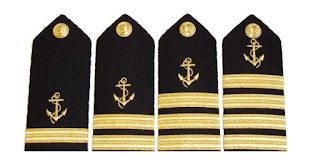WATCH KEEPING - Taking Over Watch In Port (Engine)
Taking Over a Watch
The relieving watch keeper should start at least 15 minutes before the start of watch.Start from outside the accommodation and check the following before entering engine room:
• Cargo Gear• Funnel
• Steering Gear
• Mooring winches
Deck Machinery
• Check Mooring winches and windlass:• Oil Levels
• Amperage
• Any leakage
• Any abnormal Sound while being used
Bow thruster room
• Oil level in the header tank• Bilge level
• Any leakages – Water, Hydraulic oil
Deck Machinery
• Check Hatch Cover Operating System:• Oil Levels
• Amperage
• Any leakage
• Oil temperature
• Check Hatch Covers:
• Condition of rollers
• Cleats
• Securing pins
Steering Gear
• Oil Levels• Greasing points
• Any leakage
Machinery situated outside engine room
• A.C Blowers• Emergency generator
• Battery room
• Domestic Fridge
Funnel
• Check the colour of the exhaust.• A transparent , slightly Grey smoke means good combustion
• Whitish smoke - excess air
• Blackish smoke – poor combustion due to fuel problems
• Slightly bluish smoke indicates lube oil carry over
• Identify the source – check which exhaust pipe it is coming from – Generator or Boiler.
• Some black smoke may emerge initially while starting the generator or boiler.
• Emission of black Smoke is not permitted in ports.
Engine Room
• Enter the engine room and go up the funnel casing.• Feel the Boiler safety valve vent pipe.
• If the pipe is warm, it means the safety valve is leaking
• Walking down form the funnel, check:
• Expansion tanks levels
• Ventilation Blowers.
• Engine room Overhead Crane.
• Check Fuel Tanks
• Operate the self closing drain valves on the HFO settling and service tanks
• Check the tank levels
• Heating steam
• Waste oil, Overflow, sludge tank soundings.
Lube Oil system
• L.O purifier• L.O sludge tank sounding.
Boiler
• Check the operation of the boiler control systems:• Combustion Control
• Water level control
• Blow through Gauge glass.
• Check leakages of steam, feed water
• Check flame size, colour through observation window.
• Check forced draught fan, burner motor
• Hot well water level
• Any oil in hot well steam return tank.
Generators
• Check and note how many generators are running.• Check each unit exhaust and cooling water temperatures
• Check sump sounding.
• Check lube oil pressure and temperatures.
• Feel each crank case door for temperature rise.
• Check fuel pumps and high pressure pipes.
• Check rocker arm lube oil.
• Check lube oil filter pressure difference.
• Check fuel oil filter pressure.
• Check turbocharger oil level and flow..
• Check pedestal bearing temperature, oil level and flow.
• Check oil level in governor.
Air Compressors
• Check crank case oil level.• Check suction, discharge and oil pressures.
• Check cooling water temperature.
• Check un-loader and drains.
• Check for any abnormal noise from the valves.
• Check lubricator and oil level.
• Check pressure in main and standby air bottles.
• Drain condensate from the air bottles.
• Check control air bottle, drain condensate.
• Check dryer.
Others
• Check Main engine crank case oil level.• Check Bilge levels.
• Check Bilge holding tank sounding.
• Check Stern tube header tank level.
• Check that main engine is on preheat.
• Maintain Jacket water temperature.
• Any ongoing activities – fuel oil transfer, ballasting etc.
• Details of work being carried out in engine room.
.png)



























